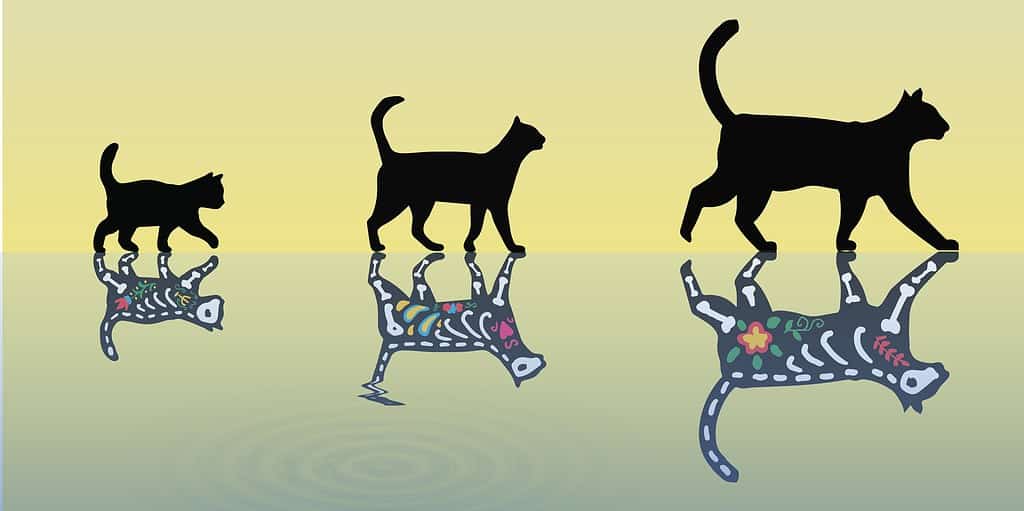
You’ve probably heard about the famous thought experiment that involves Schrödinger’s cat, which can be both alive and dead at the same time. Although it sounds like nonsense in everyday life, scientists have been able to explore analogous situations in the laboratory by using atoms or molecules in quantum mechanical superposition states of being in two places at the same time.
Superposition is only possible in the microcosmos for more quantum objects, such as electrons. Or so we thought.
In a new study, a team of researchers led by Yiwen Chu, a professor at the Laboratory for Solid State Physics at ETH Zurich, has created the heaviest Schrödinger’s cat yet by putting a small crystal into a superposition of two oscillation states.
Creating a Schrödinger Cat
In the original thought experiment, Austrian quantum physicist Edwin Schrödinger imagined a cat locked inside a metal box with a radioactive substance, a Geiger counter, and a flask of poison.
The atom in the substance may or may not decay through a quantum mechanical process with a certain probability, and the decay products might cause the Geiger counter to go off and trigger a mechanism that smashes the flask containing the poison, which would eventually kill the cat.
In this situation, according to the Copenhagen interpretation, developed in the Danish city by luminaries of quantum theory, Niels Bohr and Werner Heisenberg, the atom, and hence the cat whose faith is tied to it, are in a superposition of being decayed/dead and not decayed/alive.
Schrödinger’s thought experiment was actually devised to mock the Copenhagen interpretation, showing how quantum mechanics had been absurdly interpreted. He never contemplated the alive/dead cat superposition seriously.
Nevertheless, since his time, the cat thought experiment and the notion that quantum superpositions of macroscopic states could be possible have led to the Many-Worlds interpretation of quantum theory.
But is a macroscopic superposition really impossible?
Chu and colleagues decided to put this idea to the test. No worries, no feline was hurt in the process. Instead, they probed this question by creating a so-called “cat state” using an oscillating crystal, which is supposed to represent the cat, and a superconducting circuit representing the original decaying atom.
Weighing the Fattest Quantum Cat

The superconducting circuit can take on the logical states “0” or “1” or a superposition of both states, “0+1”. This circuit is essentially a “qubit”, or a quantum bit.
A layer of piezoelectric material creates an electric field when the crystal changes shape while oscillating, and that electric field can be coupled to the electric field of the qubit. Hence, the superposition state of the qubit can be transferred to the crystal. As a result, the crystal can now oscillate in two directions at the same time—up/down and down/up, for instance. Those two directions represent the “alive” or “dead” states of the cat.
By putting the two oscillation states of the crystal in a superposition, Chu’s team has effectively created a Schrödinger cat weighing 16 micrograms, which is roughly the mass of a fine grain of sand but nowhere near that of a cat. Nevertheless, it is several billion times heavier than an atom or molecule, making it the fattest quantum cat to date.
Why This Matters
Quantum mechanics is the physics of the small: the theory governs the behavior of atoms and particles on microscopic scales. Yet, scientists have long puzzled over why these rules seemingly do not apply to the macroscopic world we experience.
Objects at the macro scale follow the laws of classical physics, which describe how everyday things move and behave. The question remains: where does the transition from the quantum to the classical occur?
The answer to this fundamental question is not only of academic interest, but also of practical relevance. One of the potential applications of quantum physics is quantum computing, which could in principle solve certain problems much faster than classical computers.
One of the biggest challenges in developing quantum computers is to create and maintain a state of quantum superposition in a large number of qubits, which are the building blocks of quantum computers. In a Schrödinger’s cat state, the information in the qubit is distributed over a macroscopic object. This could help to overcome some of the challenges of maintaining quantum coherence in large systems.
The research has several implications for the future. First, the creation of more robust quantum bits. Second, the findings help scientists better understand the mystery of why quantum superpositions are not observed in the macroscopic world. With the latter point in mind, Chu’s team hopes to push the mass limits of her crystal cats even further in the future.
In addition, this research may lead to measuring small disturbances, which are difficult to detect using conventional methods. According to Chu, “One potential application could be the detection of very weak electric or magnetic fields.”
The oscillations in the crystal can be disturbed by an external field, and this change can be measured by the superconducting qubit. By detecting the change in the superposition state of the cat, the external field can be measured. This can be useful in detecting tiny changes in magnetic fields, which can be applied in medical imaging or quantum communication.
The work of Chu and her colleagues marks an important step towards realizing the elusive Schrödinger’s cat state in a macroscopic object. While a real cat may never be in such a state, the experiment provides insight into the puzzling boundary between the quantum and classical worlds and could pave the way towards new technologies.
The findings appeared in the journal Science.









